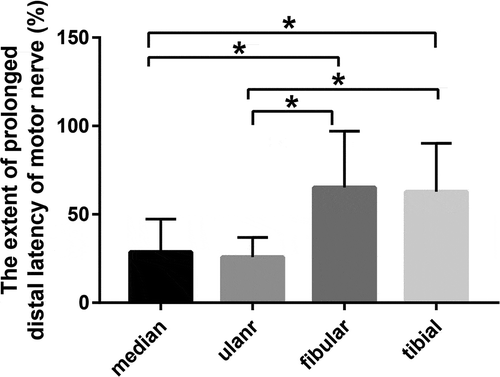Figures & data
Table 1. Age and gender of patients
Table 2. Detailed characteristics of patients with nitrous oxide abuse
Table 3. Abnormal rate of electrophysiological parameters in patients diagnosed with N2O abuse (n = 20)
Figure 1. Comparison of DML extension in the limbs of patients with nitrous oxide abuse. Percentage of the extended DML was calculated as described in the methods. Vertical axis: Extent of prolonged distal latency of motor nerve (%), horizontal axis: nerves examined. DML: distal motor latency. *P < 0.05, N = 20

Figure 2. Comparison of MNCV decrease, CMAP amplitude decrease, and SNCV decrease in the limbs of patients diagnosed with nitrous oxide abuse. Percentage of the extended MNCV decrease (A), CMAP amplitude decrease (B), and SNCV decrease (C) was calculated as described in the methods. Vertical axes: Extent of MNCV decrease (A), CMAP amplitude decrease (B), and SNCV decrease (C); horizontal axes: nerves examined. MNCV: motor nerve conduction velocity; CMAP: compound muscle action potential; SNCV: sensory nerve conduction velocity; AE: above elbow; BE: below elbow; BF: below fibular head. N = 20. There was no difference in the extent of MNCV decrease, SNCV decrease, and CMAP amplitude decrease between the upper and lower limb nerves in the patients with nitrous oxide abuse

Table 4. Electrophysiological parameters in controls and patients diagnosed with N2O, GBS-AIDP, GBS-AMAN and DPN
